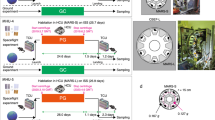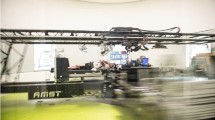Abstract
The effects of long-term reduced (lunar) gravity are very much unknown. The Apollo Program represents our only experience with humans in extended lunar gravity. Those exposures were brief, but few if any major medical issues were encountered that cannot be ascribed to issues other than reduced gravity. Animal experiments will be of great value in elucidating partial-g effects, but they have uncertain transfer to human responses; the best of these experiments are being performed now (2021) with rodents on an ISS centrifuge. We might expect that some of the main physiological issues that occur in extended weightlessness (e.g., ISS) will manifest also in extended lunar gravity, but this is far from certain. The reduced but non-zero gravity level on the moon may well be sufficient to halt or dramatically reduce the main aspects of physiological deconditioning seen in weightlessness. Those aspects that are not sufficiently alleviated in this way might benefit from additional exercise and intermittent exposures to higher gravity levels.
Access this chapter
Tax calculation will be finalised at checkout
Purchases are for personal use only
Similar content being viewed by others
References
Antonsen, E. L., Mulcahy, R. A., Rubin, D., Blue, R. S., Canga, M. A., & Shah, R. (2018). Prototype development of a tradespace analysis tool for spaceflight medical resources. Aerospace Medicine and Human Performance, 89, 108.
Aubert, A. E., Larina, I., Momken, I., Blanc, S., White, O., Prisk, G. K., & Linnarsson, D. (2016). Towards human exploration of space: The THESEUS review series on cardiovascular, respiratory, and renal research priorities. npj Microgravity, 2, 1.
Barratt, M. R., Baker, E., & Pool, S. L. (Eds.). (2019). Principles of clinical medicine for space flight (2nd ed.). Springer.
Blue, R. S., Bayuse, T. M., Daniels, V. R., Wotring, V. E., Suresh, R., Mulcahy, R. A., & Antonsen, E. L. (2019). Supplying a pharmacy for NASA exploration spaceflight: Challenges and current understanding. Npj Microgravity, 5, 1.
Canga, M., Shah, R. V., Mindock, J., & Antonsen, E. L. (2016). A strategic approach to medical care for exploration missions. In IAC-16, E3, 6, 11, x35540, 67th International Astronautical Congress, Guadalajara, Mexico.
Chancellor, J. C., Scott, G. B., & Sutton, J. P. (2014). Space radiation: The number one risk to astronaut health beyond low earth orbit. Life, 4, 491.
Clément, G. R., Bukley, A. P., & Paloski, W. H. (2015). Artificial gravity as a countermeasure for mitigating physiological deconditioning during long-duration space missions. Frontiers in Systems Neuroscience, 9, 92.
Crucian, B. E., Makedonas, G., Sams, C. F., Pierson, D. L., Simpson, R., Stowe, R. P., Smith, S. M., Zwart, S. R., Krieger, S. S., Rooney, B., & Douglas, G. (2020). Countermeasures-based improvements in stress, immune system dysregulation and latent herpesvirus reactivation onboard the International Space Station—Relevance for deep space missions and terrestrial medicine. Neuroscience & Biobehavioral Reviews, 115, 68.
Globus, R. K., & Morey-Holton, E. (2016). Hindlimb unloading: Rodent analog for microgravity. Journal of Applied Physiology, 120, 1196.
Johnston, R. S., Dietlein, L. F., & Berry, C. A. (Eds.). (1975). Biomedical results of Apollo. Scientific and Technical Information Office, National Aeronautics and Space Administration.
Karmali, F., & Shelhamer, M. (2008). The dynamics of parabolic flight: Flight characteristics and passenger percepts. Acta Astronautica, 63, 594.
Kassemi, M., Brock, R., & Nemeth, N. (2011). A combined transport-kinetics model for the growth of renal calculi. Journal of Crystal Growth, 332, 48.
Kokhan, V. S., Lebedeva-Georgievskaya, K. B., Kudrin, V. S., Bazyan, A. S., Maltsev, A. V., & Shtemberg, A. S. (2019). An investigation of the single and combined effects of hypogravity and ionizing radiation on brain monoamine metabolism and rats’ behavior. Life Sciences in Space Research, 20, 12.
Lackner, J. R., & DiZio, P. (2000). Artificial gravity as a countermeasure in long-duration space flight. Journal of Neuroscience Research, 62, 169.
Lang, T., Van Loon, J. J., Bloomfield, S., Vico, L., Chopard, A., Rittweger, J., Kyparos, A., Blottner, D., Vuori, I., Gerzer, R., & Cavanagh, P. R. (2017). Towards human exploration of space: The THESEUS review series on muscle and bone research priorities. npj Microgravity, 3, 1.
Lee, A. G., Mader, T. H., Gibson, C. R., Tarver, W., Rabiei, P., Riascos, R. F., Galdamez, L. A., & Brunstetter, T. (2020). Spaceflight associated neuro-ocular syndrome (SANS) and the neuro-ophthalmologic effects of microgravity: A review and an update. npj Microgravity, 6, 1.
Moreno-Villanueva, M., & Wu, H. (2019). Radiation and microgravity—Associated stress factors and carcinogensis. REACH, 13, 100027.
Pietrzyk, R. A., Jones, J. A., Sams, C. F., & Whitson, P. A. (2007). Renal stone formation among astronauts. Aviation, Space, and Environmental Medicine, 78, A9.
Reyes, D. P., Carroll, D. J., Walton, M. E., Antonsen, E. L., & Kerstman, E. L. (2020). Probabilistic risk assessment of prophylactic surgery before extended-duration spaceflight. Surgical Innovation. https://doi.org/10.1177/1553350620979809
Scheuring, R. A., Jones, J. A., Novak, J. D., Polk, J. D., Gillis, D. B., Schmid, J., Duncan, J. M., & Davis, J. R. (2008). The Apollo Medical Operations Project: Recommendations to improve crew health and performance for future exploration missions and lunar surface operations. Acta Astronautica, 63, 980.
Shelhamer, M. (2019). Maintaining crew & mission health & performance in ventures beyond near-earth space. In L. Johnson & R. Hampson (Eds.), Homo Stellaris. Baen.
Shelhamer, M. (2020). Human enhancements: New eyes and ears for Mars. In K. Szocik (Ed.), Human enhancements for space missions. Springer.
Voorhies, A. A., Ott, C. M., Mehta, S., Pierson, D. L., Crucian, B. E., Feiveson, A., Oubre, C. M., Torralba, M., Moncera, K., Zhang, Y., & Zurek, E. (2019). Study of the impact of long-duration space missions at the International Space Station on the astronaut microbiome. Scientific Reports, 9, 1.
Yaden, D. B., Iwry, J., Slack, K. J., Eichstaedt, J. C., Zhao, Y., Vaillant, G. E., & Newberg, A. B. (2016). The overview effect: Awe and self-transcendent experience in space flight. Psychology of Consciousness: Theory, Research, and Practice, 3, 1.
Author information
Authors and Affiliations
Corresponding author
Editor information
Editors and Affiliations
Rights and permissions
Copyright information
© 2021 The Author(s), under exclusive license to Springer Nature Switzerland AG
About this chapter
Cite this chapter
Shelhamer, M. (2021). Consideration of the Long-Term Effects of Hypogravity. In: Rappaport, M.B., Szocik, K. (eds) The Human Factor in the Settlement of the Moon. Space and Society. Springer, Cham. https://doi.org/10.1007/978-3-030-81388-8_7
Download citation
DOI: https://doi.org/10.1007/978-3-030-81388-8_7
Published:
Publisher Name: Springer, Cham
Print ISBN: 978-3-030-81387-1
Online ISBN: 978-3-030-81388-8
eBook Packages: Physics and AstronomyPhysics and Astronomy (R0)




